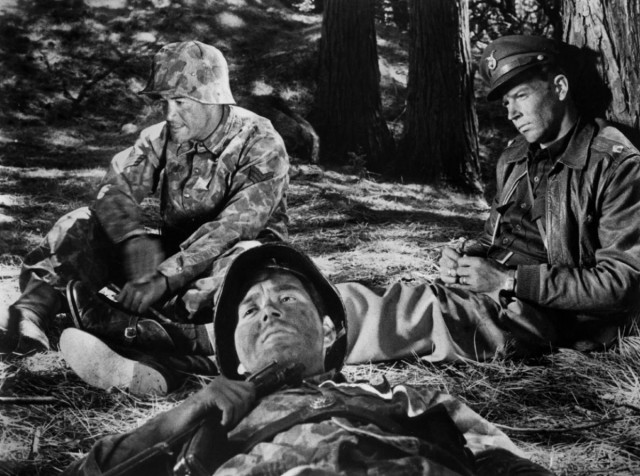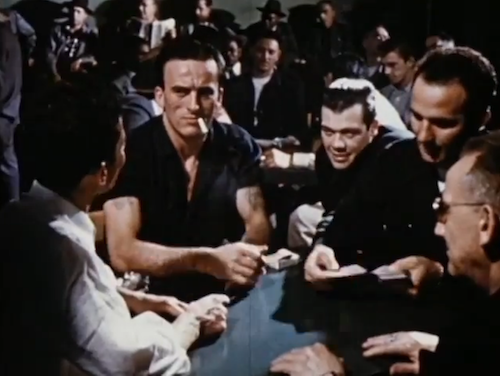
Stanley Kubrick’s first feature-length film, FEAR AND DESIRE, is screening at IFC retrospective with bonus treat
FEAR AND DESIRE (Stanley Kubrick, 1953) / THE SEAFARERS (Stanley Kubrick, 1953)
IFC Center
323 Sixth Ave. at West Third St.
Monday, January 30, 12:20 & 7:30
Series runs through February 2
212-924-7771
www.ifccenter.com
 IFC Center is celebrating the January 27 theatrical release of Alex Infascelli’s documentary S Is for Stanley, about longtime Stanley Kubrick aide Emilio D’Alessandro, with a two-week festival that includes every one of the Bronx-born ex-pat’s feature works, nearly all of which are being projected in DCP, along with a pair in 35mm. Kubrick’s 1953 seldom-seen psychological war drama, Fear and Desire, will be shown on January 30, along with the auteur’s half-hour industrial short The Seafarers. His first full-length film, made when he was twenty-four, Fear and Desire is a curious tale about four soldiers (Steve Coit, Kenneth Harp, Paul Mazursky, and Frank Silvera) trapped six miles behind enemy lines. When they are spotted by a local woman (Virginia Leith), they decide to capture her and tie her up, but leaving Sidney (Mazursky) behind to keep an eye on her turns out to be a bad idea. Meanwhile, they discover a nearby house that has been occupied by the enemy and argue over whether to attack or retreat. Written by Howard Sackler, who was a high school classmate of Kubrick’s in the Bronx and would later win the Pulitzer Prize for The Great White Hope, and directed, edited, and photographed by the man who would go on to make such war epics as Paths of Glory, Full Metal Jacket, and Dr. Strangelove, or How I Learned to Stop Worrying and Love the Bomb, Fear and Desire features stilted dialogue, much of which is spoken off-camera and feels like it was dubbed in later. Many of the cuts are jumpy and much of the framing amateurish. Kubrick was ultimately disappointed with the film and wanted it pulled from circulation; instead it was preserved by Eastman House in 1989 and restored twenty years later, which is good news for film lovers, as it is fascinating to watch Kubrick learning as the film continues. His exploration of the psyche of the American soldier is the heart and soul of this compelling black-and-white war drama that is worth seeing for more than just historical reasons. “There is a war in this forest. Not a war that has been fought, nor one that will be, but any war,” narrator David Allen explains at the beginning of the film. “And the enemies who struggle here do not exist unless we call them into being. This forest then, and all that happens now, is outside history. Only the unchanging shapes of fear and doubt and death are from our world. These soldiers that you see keep our language and our time but have no other country but the mind.”
IFC Center is celebrating the January 27 theatrical release of Alex Infascelli’s documentary S Is for Stanley, about longtime Stanley Kubrick aide Emilio D’Alessandro, with a two-week festival that includes every one of the Bronx-born ex-pat’s feature works, nearly all of which are being projected in DCP, along with a pair in 35mm. Kubrick’s 1953 seldom-seen psychological war drama, Fear and Desire, will be shown on January 30, along with the auteur’s half-hour industrial short The Seafarers. His first full-length film, made when he was twenty-four, Fear and Desire is a curious tale about four soldiers (Steve Coit, Kenneth Harp, Paul Mazursky, and Frank Silvera) trapped six miles behind enemy lines. When they are spotted by a local woman (Virginia Leith), they decide to capture her and tie her up, but leaving Sidney (Mazursky) behind to keep an eye on her turns out to be a bad idea. Meanwhile, they discover a nearby house that has been occupied by the enemy and argue over whether to attack or retreat. Written by Howard Sackler, who was a high school classmate of Kubrick’s in the Bronx and would later win the Pulitzer Prize for The Great White Hope, and directed, edited, and photographed by the man who would go on to make such war epics as Paths of Glory, Full Metal Jacket, and Dr. Strangelove, or How I Learned to Stop Worrying and Love the Bomb, Fear and Desire features stilted dialogue, much of which is spoken off-camera and feels like it was dubbed in later. Many of the cuts are jumpy and much of the framing amateurish. Kubrick was ultimately disappointed with the film and wanted it pulled from circulation; instead it was preserved by Eastman House in 1989 and restored twenty years later, which is good news for film lovers, as it is fascinating to watch Kubrick learning as the film continues. His exploration of the psyche of the American soldier is the heart and soul of this compelling black-and-white war drama that is worth seeing for more than just historical reasons. “There is a war in this forest. Not a war that has been fought, nor one that will be, but any war,” narrator David Allen explains at the beginning of the film. “And the enemies who struggle here do not exist unless we call them into being. This forest then, and all that happens now, is outside history. Only the unchanging shapes of fear and doubt and death are from our world. These soldiers that you see keep our language and our time but have no other country but the mind.”

Stanley Kubrick cut his teeth making such promotional films as THE SEAFARERS
Fear and Desire lays the groundwork for much of what is to follow in Kubrick’s remarkable career; however, the same can’t be said for The Seafarers, a promotional short he directed and photographed in 1953 for the Seafarers International Union, aka the SIU, which is still in existence. “This is a story simple but dramatic, a story about the men who crew our ships, the seafarers,” television newsman Don Hollenbeck, who narrates the film, says in an onscreen preface. The straightforward script, written by Will Chasan, discusses how the union works, detailing responsibilities, benefits, job security, procedures, and more as Kubrick’s camera roams a hiring hall, a food station, various ports, a card game, the Seafarers Log printing press, and a barbershop with a nudie calendar, all set to a splendidly clichéd, lilting musical score. Kubrick also takes viewers inside an actual meeting, where secretary-treasurer Paul Hall gives a speech; Hall went on to become the SIU’s second president and in 1967 was honored with the naming of the Paul Hall Center for Maritime Training and Education in Maryland. Kubrick’s first color film, The Seafarers doesn’t lend a whole lot of insight into his methods, but it is a treat that will satisfy completists. Kubrick was also going to make The Halifax Story, about the 1949 Canadian Seamen’s Union strike, but that project never reached fruition. The IFC Center series continues through February 2 with all of Kubrick’s feature films in addition to Steven Spielberg’s A.I. Artificial Intelligence, based on a treatment by Kubrick. S Is for Stanley director Infascelli will be on hand for Q&As following screenings of his Italian documentary on Friday at 8:00 and Saturday at 7:15.